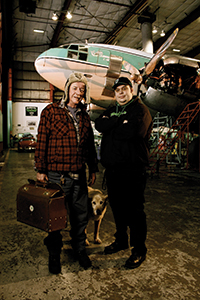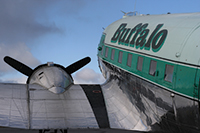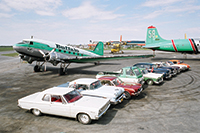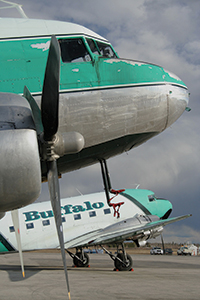
Features
Operations
Inside the green machine
If you’re a true aviation enthusiast, it’s hard not to be intrigued by the Buffalo Airways story. Based in Yellowknife, N.W.T., this iconic operation profiled in the hit television series Ice Pilots NWT, has served the far north since 1970, providing national and international air support services, including cargo shipments, fire suppression and passsenger transfers.
November 3, 2011 By Peter Pigott

|
|
| Buffalo Airways president “Buffalo” Joe McBryan (left) is now a legend worldwide thanks to the popularity of Ice Pilots NWT.
|
If you’re a true aviation enthusiast, it’s hard not to be intrigued by the Buffalo Airways story. Based in Yellowknife, N.W.T., this iconic operation profiled in the hit television series Ice Pilots NWT, has served the far north since 1970, providing national and international air support services, including cargo shipments, fire suppression and passenger transfers. So, how did it all happen for Buffalo Airways, its president “Buffalo” Joe McBryan and his adventurous pilots, engineers and crew? Wings correspondent Peter Pigott sat down with general manager Mikey McBryan, Joe McBryan’s son, to get an inside look at this unique northern operation.
WINGS: Because of the television series Ice Pilots NWT, Buffalo Airways is probably the most famous airline in Canada. How did it begin?
Mikey McBryan: My dad and four guys founded Buffalo Airways. There are different versions, but the current one is that the old man and three other guys bought the company from Bob Gauthier in May 1970. Eventually, he bought out the three other guys and has been running it solo ever since.
WINGS: How is it organized? Are there shareholders and a board of directors?
MM: It’s a strict dictatorship. They sent me to business school and there definitely isn’t a Buffalo business model. It’s run the way Cuba would be run.
WINGS: How did you get into it and what’s your role?
MM: I was bred to do this right from Day 1. I grew up in Hay River and my dad flew us into Yellowknife in the DC-3 every day since 1982. If you do the math, it’s like 300 days a year for 30 years. I’m not a pilot, but a mechanic – actually I’m going back to do a refresher on DC-4s. But I do all the charter work, organize all the pilots, absolutely everything. I was told I was doing this just like a dictatorship. But with a dictatorship there comes a lot of freedom. There’s no red tape – if there is one guy in charge (my dad) there are no “maybes” only yes or no. It’s, “Mikey, go get the airplane ready by any means necessary” or “get the freight there by any means necessary.”
WINGS: “Buffalo Joe” McBryan has become a legend around the world. How would you describe your dad?
MM: My father is very eccentric. He has an uneducated business mind; never spent a day in the classroom. He has learned all by experience and mistakes. He does all the negotiations by himself. The forest fire contract he got for us in 1995, he took on Conair, the biggest firefighting company in the world. He’s very stubborn: once he gets his mind on something he gets it done. And at any given time his wardrobe is $35. He lives off café food, cans of beans. It’s almost like there’s seven different personalities in him. My mom and him have been married some 45 years and even she can’t figure him out.

|
|
| The DC-4 and the DC-3 remain the backbone of the Buffalo Airways fleet. “I have to check Wikipedia to see how many aircraft we have,” says general manager Mikey McBryan.
|
WINGS: It sounds like he’s very hands-on in the day-to-day operations as well.
MM: He still flies every day – works from six in the morning to nine at night. He never takes weekends off, he will never ask someone to do something that he doesn’t want to do himself. In one of the TV episodes, he is the one who cleans the cat litter. And he does that because he feels bad asking other people to do it. Whatever breaks down, he’s got a spare. He’s got backups on backups on backups. That’s how he operates. Every day, he buys more airplanes – he just bought two more DC-3s without telling anybody. So, that’s 15 DC-3s. I have to check Wikipedia to see how many aircraft we have – I think there’s 50 airframes, 26 working aircraft. We just bought a Canadair CL-215 off e-Bay. Now we have 11 DC-4s, 15 DC-3s, three C-46s, one Norseman, one Vampire fighter jet that he got in some horse trading deal somewhere which is sitting in the Edmonton Museum. You look in the corner there – there’s an Aeronca Champ – he acquired it somehow. Nothing is planned, there’s no master plan. Buffalo Airways just grew.
WINGS: What is the main focus of the Buffalo operation: is it scheduled passengers, freight or charter? Firefighting or the aviation school?
MM: The most beautiful thing about Buffalo is that whatever is available, we do. Today, there’s a lot of mining work but mining dried up in the past two years, so we moved a lot of food. We also do firefighting, parts selling, and buying and selling airplanes. Then there is Buffalo Air Express, which is a courier company, so we do FedEx, DHL, all that fun stuff.

|
|
| Founded in 1970, Buffalo Airways provides national and international air support services including cargo shipments, fire suppression and passenger transfers.
|
WINGS: With such a varied but rapidly changing operation, how does Buffalo keep thriving?
MM: It’s magic sometimes where the money comes from in aviation. We don’t really know – as long as the cheques are cashed and the airplanes kept in the air.
WINGS: There’s a stack of CVs and emails on your desk. Given the current economic conditions, why do so many young pilots want to work for you?
MM: Buffalo Air is actually a very hard job. I don’t recommend it for anybody, but it’s a shortcut to the cockpit. For example, I have a guy called Larry. He’s 20 years old, he was on the ramp for eight months and he’s co-pilot on the C-46 right now. Anywhere else you’ve got to work four to five years to get into the cockpit. By the time he’s 25, he’ll have enough time to be captain on a jet. But they pay their dues on the ramp. You’ve really got to put them through the wringer. It costs a lot to check out a pilot. An aircraft like the L-188 Lockheed Electra, you’re looking at about $5,000 an hour. A 10-hour flight, you’re looking at $50,000. At the end of the day, the guys are worn out and look like skid-row bums – they’ve really got to want it. Most don’t make it.
WINGS: Sounds like a tremendous experience for a young guy. The TV series depicts some real characters. Are they true to life?
MM: The two pilots I have right now – Justin Simle, chief pilot, and AJ Descoste, our pilot of everything – started green, green, green and now they fly absolutely everything we have. They’re one out a hundred – getting to the point where they can fly absolutely everything. Most young guys do their time here and then go south to the airlines. So for us, to get a “lifer,” you have to go through a hundred guys. It took them nine years to get this far. They could make more money with the airlines but these guys really, really want to fly. And you wouldn’t get so much of that with the airlines.

|
|
| A group of vintage car enthusiasts from Alaska gather their cars in front of C-GPNR after going for a short flight with Joe in his DC-3.
|
WINGS: So, it’s a very unique operation supported by a very unique group of individuals.
MM: There’s an old Christmas movie (Rudolph the Red-Nosed Reindeer). It mentions, “the island of the misfit toys.” We’re like that. Buffalo is different for a reason, and the reason is the people. It’s almost like a fraternity – you’re put through the wringer and are really part of something.
WINGS: Most of your aircraft – the DC-3s, DC-4s and C-46s – date from the Second World War. How do you get spare parts or even people who know to work on them?
MM: All the people who designed DC-3s are dead. There is no one who can train you on World War II aircraft. The mechanics, a lot of them, are family. Fathers, uncles and brothers, not from the McBryan family but family in their own right. They’ve raised their kids as mechanics – and you can’t really go to school to work on a DC-3. Spare parts? We have a World War II hangar in Red Deer, Alta., that is packed to the roof with parts. It’s like a Buffalo Airways Wal-Mart when you go in there. And the old man, he’s got it all in his memory. He’ll say, “Walk 10 feet, pick up a box or dust off an old mattress and underneath there it is.” It’s a very eccentric way of running a business but it’s all there.
WINGS: How do you stay in business being located so far north?
MM: There are no roads up here so everything is flown in. The Northwest Territories is as flat and boring as it looks, but it’s one of the richest mineral deposits in the world. You’ve got diamonds next to nickel, next to uranium, next to gold – minerals that I don’t even know the names of. There are even rare earth metals that they need to put into flat-screen TVs. Aircraft are the only way in or out.

|
|
| C-GTXW gets a scheduled maintenance check completed in the Yellowknife hangar. The Pratt & Whitney R2800 is shown underneath its large cowling.
|
WINGS: If it’s so lucrative, why doesn’t Buffalo scrap these Second World War aircraft for Lockheed Hercules like First Air did?
MM: Because they’re expensive. For a Herc, you’re looking at $23 million minimum. But a DC-3 costs, if you buy it from the sheriff, $70,000. Call it $250,000 by the time you clean it up and put in the modern stuff. You make that in a month out here. These DC-3s were all bought in the 1970s and they’ve not only paid for themselves but also paid for the whole company.
WINGS: Let’s talk about the television series Ice Pilots NWT. How has it affected your life and Buffalo Airways?
MM: We’ve been doing it for three and half years now – we’re known around the world – but we’re still isolated. You’re famous but you’re still in the freezer. You don’t get to go out into the kitchen; we’re not in downtown Toronto high on cocaine and acting like Charlie Sheen driving around. We’re still working our tails off in the freezer. It’s a weird thing. But the television show is very truthful; it’s 100 per cent my life. The crew goes to our homes and films whatever you see on TV. Whatever is on TV is my day.
WINGS: Does your dad watch the show?
MM: He watches it the same as everyone else. I go to Vancouver to make sure it’s somewhat accurate, that we’re not breaking any laws. But he doesn’t believe it – this is his world and he can’t believe it’s on TV.
WINGS: “Buffalo Joe” is one of the legendary aviators who built the North like “Punch” Dickins or Max Ward. You know him best. What’s he like in real life?
MM: Dad doesn’t have a bankcard: he uses a credit card that the accountant pays off. He lives on his cellphone and he’s got an old school computer that he’s got set up so he can search for Ford Mercury car parts. In his mind, he’s got 22 cars but actually, he’s got more than 100. He’s got 20 here and the rest are in Red Deer. All vintage cars that he grew up with he has, the greasers. Basically his style is James Dean.
He wears the same clothes that he did in the 1970s because once he began working for himself, he never had a boss to tell him to put on a suit. His daily cars are crappy Ford Rangers. He never goes on a normal vacation, doesn’t go to Arizona. His vacation is going to junkyards to buy parts for his Mercuries. He’s always been a diamond in the rough – he’s always looking for a good deal. You cannot peg him, he has a very good talent of adapting towards the person he is currently with. In his car life, no one knew he was a pilot. They thought he was a car fanatic. And fame hasn’t changed him except that now when he goes to car shows people recognize him from the TV. He says he is going to have to start attending art shows or history lectures so no one will know him.

|
|
| C-GWZS (front) and C-GWIR (back) in Hay River after a second scheduled night.
|
WINGS: What’s going to happen when “Buffalo Joe” is no longer there? Are you going to take over?
MM: My dad is 67, I’m 28. His dad (my grandfather) is 91 and the oldest man in Hay River. So, we’ve got about 20 years at least. We’ll see how it goes.
WINGS Why the name Buffalo Airways and the green paint scheme?
MM: He originally wanted to call it “Big Indian Airways” but there was already “Big Indian Trucking.” Why Buffalo? It was named for Wood Buffalo National Park, which is the largest park up here. And why green? There are 10 different stories – the guy who taught him to fly had a green airplane. Also, it’s now environmentally sound – yes, we can say we’ve been “green” since 1970. My dad says if he had to do it all over again he would have chosen bright orange because you can see bright orange a mile off.
Wings correspondent Peter Pigott would like to thank Buffalo Airways’ Peter Magill for arranging the interview.